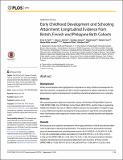Early Childhood Development and Schooling Attainment: Longitudinal Evidence from British, Finnish and Philippine Birth Cohorts

View/
Author
Peet, Evan D.
Ezzati, Majid
Jarvelin, Marjo-Riitta
Pillas, Demetris
Published Version
https://doi.org/10.1371/journal.pone.0137219Metadata
Show full item recordCitation
Peet, Evan D., Dana C. McCoy, Goodarz Danaei, Majid Ezzati, Wafaie Fawzi, Marjo-Riitta Jarvelin, Demetris Pillas, and Günther Fink. 2015. “Early Childhood Development and Schooling Attainment: Longitudinal Evidence from British, Finnish and Philippine Birth Cohorts.” PLoS ONE 10 (9): e0137219. doi:10.1371/journal.pone.0137219. http://dx.doi.org/10.1371/journal.pone.0137219.Abstract
Background: While recent literature has highlighted the importance of early childhood development for later life outcomes, comparatively little is known regarding the relative importance of early physical and cognitive development in predicting educational attainment cross-culturally. Methods: We used prospective data from three birth cohorts: the Northern Finland Birth Cohort of 1986 (NFBC1986), the 1970 British Cohort Study (BCS1970), and the Cebu Longitudinal Health and Nutrition Survey of 1983 (CLHNS) to assess the association of height-for-age z-score (HAZ) and cognitive development measured prior to age 8 with schooling attainment. Multivariate linear regression models were used to estimate baseline and adjusted associations. Results: Both physical and cognitive development were highly predictive of adult educational attainment conditional on parental characteristics. The largest positive associations between physical development and schooling were found in the CLHNS (β = 0.53, 95%-CI: [0.32, 0.74]) with substantially smaller associations in the BCS1970 (β = 0.10, 95% CI [0.04, 0.16]) and the NFBC1986 (β = 0.06, 95% CI [-0.05, 0.16]). Strong associations between cognitive development and educational attainment were found for all three cohorts (NFBC1986: β = 0.22, 95%-CI: [0.12, 0.31], BCS1970: β = 0.58, 95%-CI: [0.52, 0.64], CLHNS: β = 1.08, 95%-CI: [0.88, 1.27]). Models jointly estimating educational associations of physical and cognitive development demonstrated weaker associations for physical development and minimal changes for cognitive development. Conclusion: The results indicate that although physical and cognitive early development are both important predictors of educational attainment, cognitive development appears to play a particularly important role. The large degree of heterogeneity in the observed effect sizes suggest that the importance of early life physical growth and cognitive development is highly dependent on socioeconomic and institutional contexts.Other Sources
http://www.ncbi.nlm.nih.gov/pmc/articles/PMC4564180/pdf/Terms of Use
This article is made available under the terms and conditions applicable to Other Posted Material, as set forth at http://nrs.harvard.edu/urn-3:HUL.InstRepos:dash.current.terms-of-use#LAACitable link to this page
http://nrs.harvard.edu/urn-3:HUL.InstRepos:22856896
Collections
- SPH Scholarly Articles [6362]
Contact administrator regarding this item (to report mistakes or request changes)


